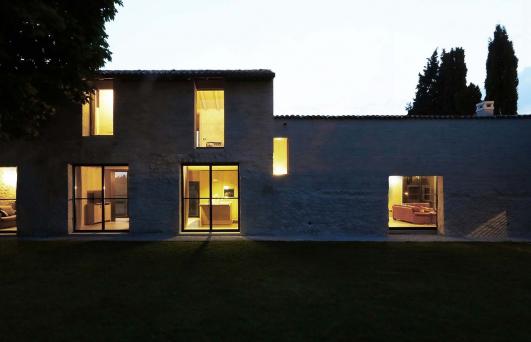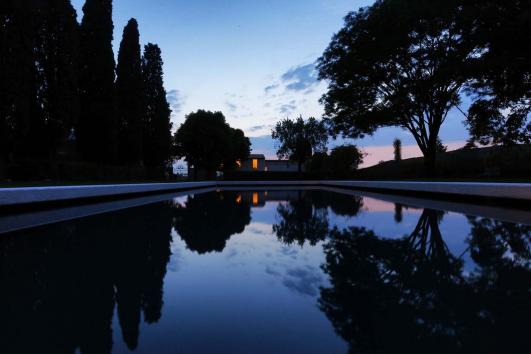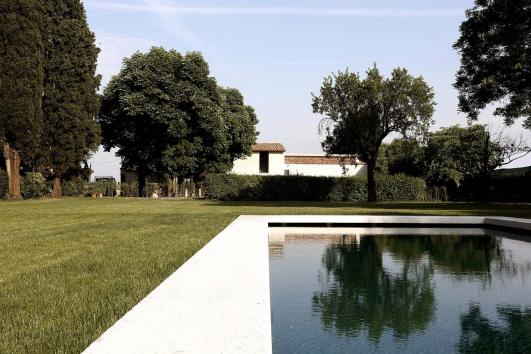Villa Brolo Saccomani Renovation by Bricolo Falsarella
Interior Architecture and Design
The project aimed to convert, for residential use, the rustic annexes of the eighteenth-century Villa Saccomani, located on the Moraine hills a few kilometres from Lake Garda and the city of Verona.
Before the project began, the annexes, part of the villa’s prestigious monumental park, were merely seen as areas of low, architectural value. This negative impact was mainly due to the building, in the twentieth century , of an incongruous extension obtained by elevating walls in concrete blocks on top of the original, picturesque, building which had been constructed with river stone typical of rural buildings of the area.
The project foresaw, in the first instance, the demolition of the twentieth century additions stripping the building to its original, fascinating form. Later, a new extension was built with an exposed brick finish. This allows us to clearly identify the original section from the new extension.
To reduce the excessive colour contrast that would have been formed between the two facing walls ( the colour of red brick against the grey colour of the stone) both surfaces were covered with a rope-coloured scialbatura (an antique technique that involves a type of painting with lime). Seen from a distance, within the villa’s park or the hilly landscape , the expanded building appears as unit; close up however, it is possible to clearly distinguish the original and the new, brick extension.
Nonetheless, in order to reduce the contrast of materials that would have been formed between the surface of the rustic stone base and the strong linearity of the new brick extension, we experimented with the laying of new masonry that made the visual impact of new construction less uniform. The laying of the bricks , 30 cm long , was made by rotating the long sides in a seemingly disordered way to form asymmetrical recesses with slight convex and concave corners . This solution gave the new brick surface a striking, movement of light effect, due to the creation of light shadows spread across the entire wall.
On the side facing the park, the masonry stone coincides with the ground floor and incorporates the living area while the new brickwork defines the first floor bedrooms. The brick wall on the first floor is broken with incisions that define the new windows. The windows’ profiles have been completely installed on the inside so as not to be visible and also emphasize the idea of timeless architecture. Between the window frame and the masonry, without any type of fastening beams, safety glass was installed which acts as an invisible parapet.
On the ground floor, the new windows were installed within the annex’s existing portals and were made with iron profiles in view. In this way greater abstraction is awarded to the extended parts and a more traditional aspect remains for the original section.
The lower part of the annex comprises a double height, large living room dedicated to the social life of the family and linked to the villa’s park where a new swimming pool has been built . This is the only point where a new opening towards the park was made in the original stone walls. This new opening interrupts the continuity of a high band made of re-enforced concrete that runs on all this facade and serves as both a reinforcement of the stone wall as well as offsetting the height of the original wall and part of the new brickwork aligned with the lintel of the door window.
This new door features a sliding window with concealed hinges and looks like a reinterpretation of visual porosity, typical of Veneto villas with the opening facing the inner park aligned with the opening towards the countryside. The facade of the long narrow hall towards the park is characterized by the presence of a window located at the point of transition between the double height of the hall and part of the rustic, two storey annex.
Therefore part of the window frame is made up of stone and the other half is brick , while the other part of the window is entirely brick, emphasizing the difference in height of the original wall . Towards the interior, glass has been directly inserted into the wall so that in the early hours of the morning , a beam of light falls onto the internal wall without the shadows of the window frame.
As a final point, the project involved the transformation of the “brolo” (an old orchard garden) by creating a large lawn and with the construction of a central swimming pool inspired by the traditional “peschiere” (fishponds) of Veneto villas. The pool was built eliminating the perception of all technological aspects . A 65 cm wide stone defines the boundary between the pool and the great lawn , the overflow tank has been hidden below and all around . A special green-coloured resin treatment allowed for the creation of visual effect, typical of eighteenth-century fish ponds with the water that reflects the sky, trees and buildings.

© Nicolò Galeazzi

© Nicolò Galeazzi

© Nicolò Galeazzi

© Nicolò Galeazzi

© Nicolò Galeazzi

© Filippo Bricolo

© Filippo Bricolo

© Filippo Bricolo

© Nicolò Galeazzi

© Nicolò Galeazzi

© Nicolò Galeazzi

© Nicolò Galeazzi























